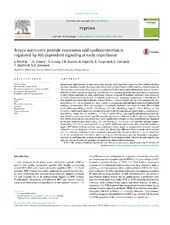| dc.description.abstract | Exogenously administered B-type natriuretic peptide (BNP) has been shown to offer cardioprotection through activation of particulate guanylyl cyclase (pGC), protein kinase G (PKG) and KATP channel opening. The current study explores if cardioprotection afforded by short intermittent BNP administration involves PI3K/Akt/p70s6k dependent signaling, and whether this signaling pathway may participate in regulation of BNP mRNA expression at early reperfusion. Isolated Langendorff perfused rat hearts were subjected to 30 min of regional ischemia and 120 min of reperfusion (IR). Applying intermittent 3 × 30 s infusion of BNP peptide in a postconditioning like manner (BNPPost) reduced infarct size by >50% compared to controls (BNPPost 17 ± 2% vs. control 42 ± 4%, p < 0.001). Co-treatment with inhibitors of the PI3K/Akt/p70s6k pathway (wortmannin, SH-6 and rapamycin) completely abolished the infarct-limiting effect of BNP postconditioning (BNPPost + Wi 36 ± 5%, BNPPost + SH-6 41 ± 4%, BNPPost + Rap 37 ± 6% vs. BNPPost 17 ± 2%, p < 0.001). Inhibition of natriuretic peptide receptors (NPR) by isatin also abrogated BNPPost cardioprotection (BNPPost + isatin 46 ± 2% vs. BNPPost 17 ± 2%, p < 0.001). BNPPost also significantly phosphorylated Akt and p70s6k at early reperfusion, and Akt phosphorylation was inhibited by SH-6 and isatin. Myocardial BNP mRNA levels in the area at risk (AA) were significantly elevated at early reperfusion as compared to the non-ischemic area (ANA) (Ctr(AA) 2.7 ± 0.5 vs. Ctr(ANA) 1.2 ± 0.2, p < 0.05) and the ischemic control tissue (Ctr(AA) 2.7 ± 0.5 vs. ischemia 1.0 ± 0.1, p < 0.05). Additional experiments also revealed a significant higher BNP mRNA level in ischemic postconditioned (IPost) hearts as compared to ischemic controls (IPost 6.7 ± 1.3 vs. ischemia 1.0 ± 0.2, p < 0.05), but showed no difference from controls run in parallel (Ctr 5.4 ± 0.8). Akt inhibition by SH-6 completely abrogated this elevation (IPost 6.7 ± 1.3 vs. IPost + SH-6 1.8 ± 0.7, p < 0.05) (Ctr 5.4 ± 0.8 vs. SH-6 1.5 ± 0.9, p < 0.05). In conclusion, Akt dependent signaling is involved in mediating the cardioprotection afforded by intermittent BNP infusion at early reperfusion, and may also participate in regulation of reperfusion induced BNP expression. | en_US |

